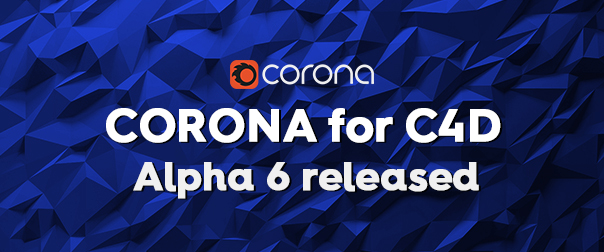
We’re pleased to unveil Corona Renderer for Cinema 4D Alpha 6 final! We’d like to thank all of you for testing the release candidates and helping us identify and resolve bugs with both the Windows and Mac versions.
Quick Facts
- Port to macOS: The port has the same features as the Windows version.
- Based on Corona 1.6 daily builds: As well as incorporating everything from 1.5 for 3ds Max, the core is based on some of the daily builds released since then.
- Simpler UI: Making it easier to find and use Corona features.
- Interactive LightMix: Now working in C4D!
- Image post processing: The core features such as bloom & glare, LUTs, filmic tone mapping etc have been ported over.
The main purpose of Alpha 6 was the integration of new features from the Corona core, and this meant rewriting a large part of the Cinema 4D version. With such a big rewrite, there were quite a few bugs in the first releases of A6, so it has taken a while for us to reach this final version with those bugs resolved!
Reworking the UI was another major part of this release. We are pleased to say that is complete and there will be only small changes needed between now and the 1.0 release – this means we can start to create help articles and tutorials now that no further major changes are needed to the UI.
Read more!
New Features
Port to macOS
This is the big one that many C4D users have been waiting for, and we are glad to say that the port is done, carrying across all the features of the Windows version.
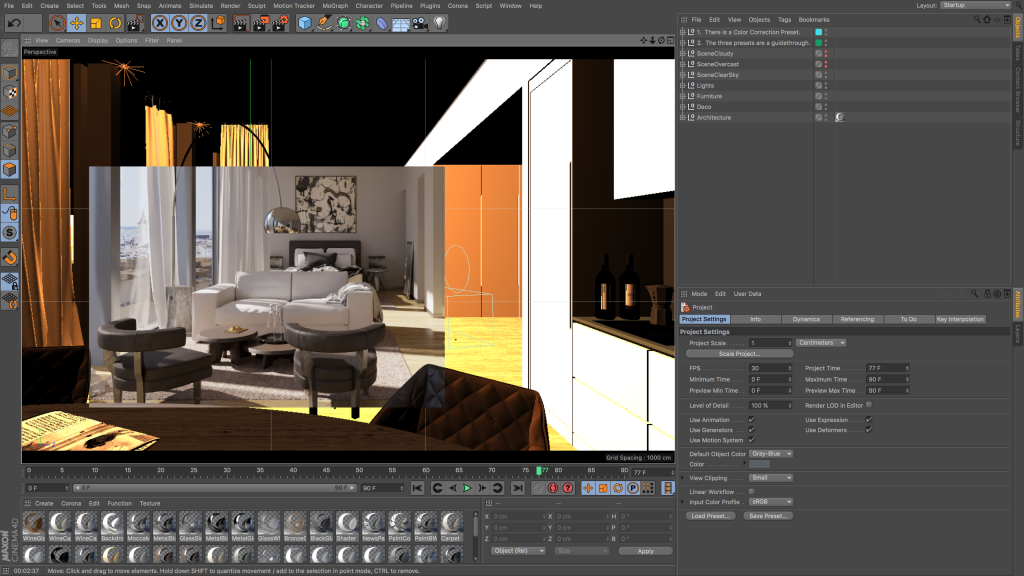
Image denoising
Offering the chance to save 50 to 70% on render times, Denoising has been incorporated into the C4D version. The image below shows where to enable Denoising before starting a render, and adjusting the Denoising amount in a finished render:
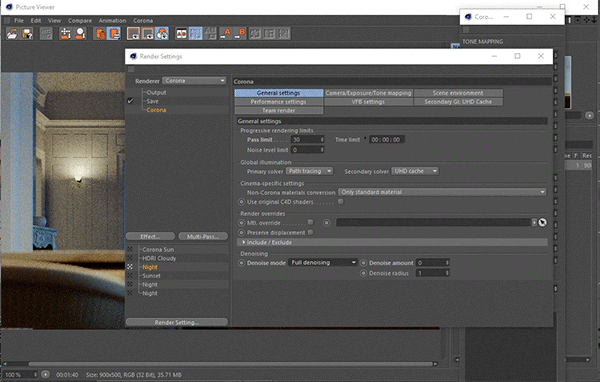
We used only 10 passes in the image below, and still, the denoised image shows no trace of noise:
Interactive LightMix
One of the most-loved features from Corona 1.5 is now in A6!
The Interactive LightMix lets you adjust color and intensity of light sources during or after rendering. This is ideal for making subtle adjustments to the warmth, color or brightness of Corona Lights or light emitting materials, and can also be used for more extreme changes like turning day into night, all without re-rendering!
As well as handling CoronaLights and materials that emit light, it also works with the CoronaSun and with environment lighting from CoronaSky or HDRI images, so that you can control all aspects of lighting without having to re-render.
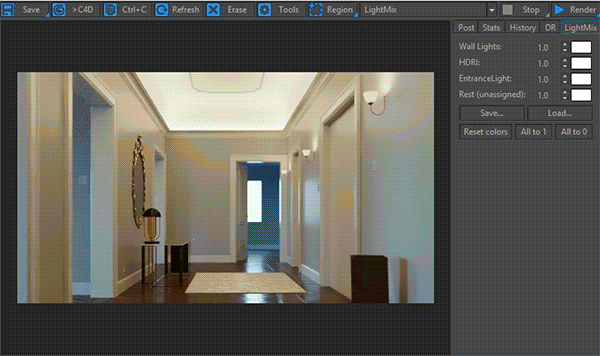
Denoising can be applied to each LightSelect pass individually. If you enable this for all LightSelect passes, then your final LightMix pass will be denoised in full, as shown in the example above. Alternatively, you can enable Denoising only for particular LightSelect passes if you want to save a little on render times and memory usage.
A short Preview video walks you through the basics of setting up and using LightMix in Alpha 6:
Post-processing
Another set of features that is hugely popular in Corona 1.5 is also incorporated in A6, reducing or removing your need to rely on third-party software for post-processing. Some of the features are demonstrated below:
Bloom
Bloom creates a large, soft glow around bright areas in the image, ideal for adding softness to windows as an example, or giving a soft glow around a candle flame. Hue Power and Shift let you adjust the hue of the effect rather than have it purely dependent on the color of the light source.
Glare
Glare creates a sharper, more-focused glow with rays from bright areas in the image. This is ideal for creating a “starburst” effect around bright highlights on cars, from bright light sources, on gemstones, etc. The Hue Power and Shift parameters affect Glare in the same way as Bloom.
Filmic Tone Mapping
Gives you control over highlights and shadows using the new filmic tone mapping. This can give more pleasing results with more ease than adjusting with the previous tools alone. Exposure, White Balance and Contrast still work alongside the Filmic highlights and shadows options.
LUTs
You can now apply a LUT (Look-Up Table) to your rendered image. This supports both .cube and .3dl format, and allows you to quickly apply the “look” of particular film stock or camera model to your render.
Corona Renderer 1.5 comes with 77 LUTs bundled in the installer – we’d like to thank Adan Martin for providing his LUTs, Ground Control for designing 10 LUTs specially for Corona, and Martin Nabelek for providing the LUTs he used in the making of award-winning short film OFF.
Saturation
Controls the color saturation across the entire image:
Vignette
Adds a circular vignette to the rendered image.
Added support for R18
Support was added for the latest release of C4D.
Changes and Improvements
CoronaMtl Improvements
The GGX BRDF was modified in the CoronaMtl to offer the full glossiness range, bringing it in line with emerging industry standards and removing any physically incorrect dark or light “halo” at the edges of rough objects. This means it now gives expected results for all Glossiness and Fresnel values.
It also makes material creation much simpler – the same workflow applies as shown in this recent tutorial for Corona Materials in 3ds Max:
For compatibility, any existing scenes will load with materials that have the new PBR mode disabled, to ensure they render without any changes to the look of the materials.
Below, you can see a comparison between PBR mode enabled and disabled, with a low glossiness material (Glossiness of 0.3) applied to the Shaderball from Mastering CGI. Note in particular the brightened edges when PBR mode is not enabled.
As well as making the behavior of materials more predictable and expected for those familiar with other software, this also gives full compatibility with materials imported from third-party software such as Allegorithmic’s Substance tools, and Quixel’s Megascans.
Better Corona Virtual Frame Buffer integration with Cinema 4D
You can now render directly to the Corona Virtual Frame Buffer (VFB) without displaying the picture viewer, and stability has been improved.
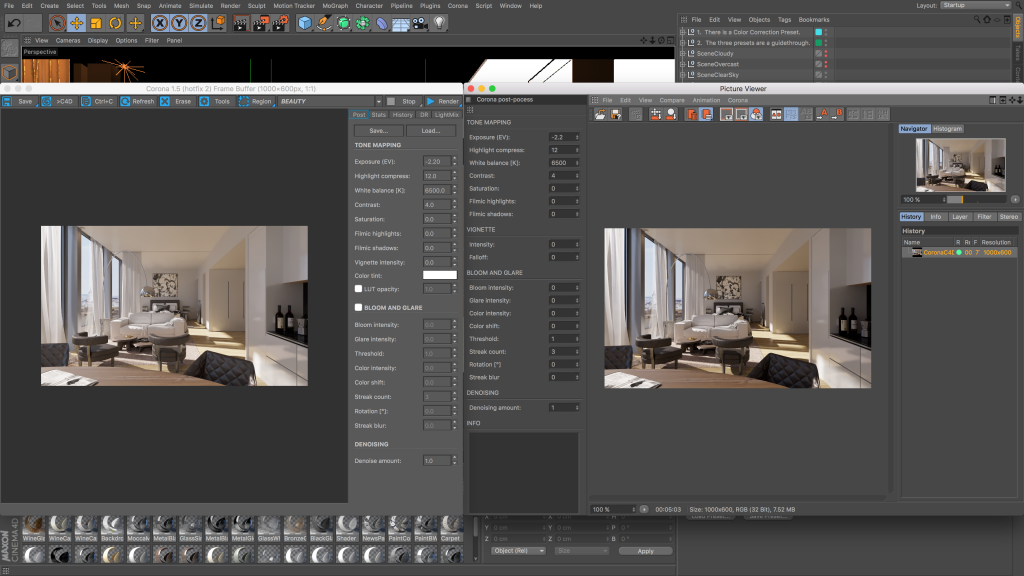
Much faster displacement pre-processing
The pre-processing of displacement has been improved – now calculating displacement is 8 times faster or more on average, but we did see speed increases of up to 40x!
Better Picture Viewer integration with Corona
The integration goes both ways –
Additional panel with post-process features
You can control all the post-processing features listed earlier from either the Corona VFB, or from the new panel added for the native Picture Viewer. Both will reflect changes in the other.
Interactive changes to post-processing even after rendering finishes
You can continue to adjust the post-processing settings in the native Picture Viewer once rendering is complete, and see the changes in real-time.
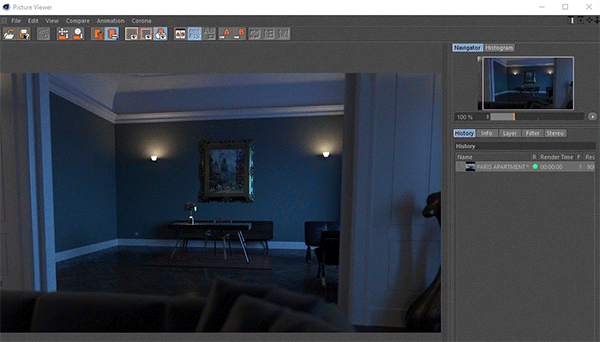
Denoising will run after stopping rendering early
Now stopping rendering will still allow Denoising to complete.
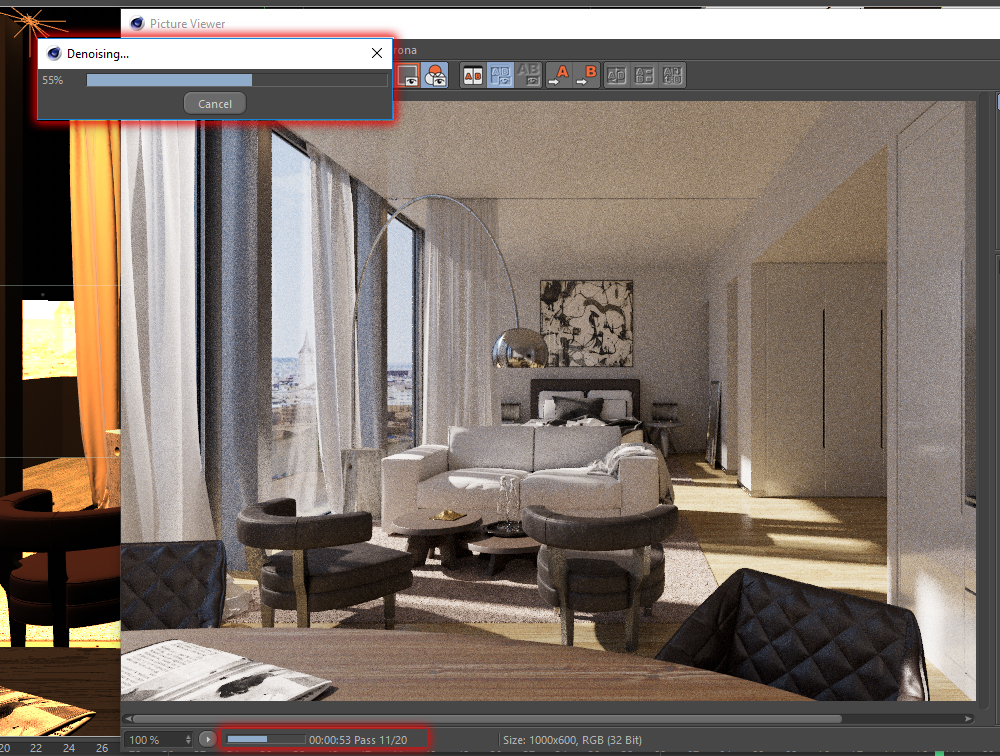
Corona Output Map
This map (found under Textures -> Corona) lets you apply color adjustments to a map or shader, such as adjusting brightness, contrast or saturation, or applying a LUT to the map or shader.
In the example below, a LUT is applied to a native C4D noise shader and the result used in the Diffuse component of the Material:
Other Improvements
- Adaptive image sampling added
- TexMap pass added
- Updated installer: (same installer as for 3ds Max).
UI Changes
More accessible plugin and materials menu
Many Corona features and menus have been moved to the top level, so that they are more easily found and accessed. If you prefer a different set up, then menus can always be edited using C4D’s “Customize menus…” feature so that you can create the set up you prefer!
Multipass Rendering
- Moved from the render settings to the plugins menu
- Improved drag & drop support
- Added list of available passes for faster workflow
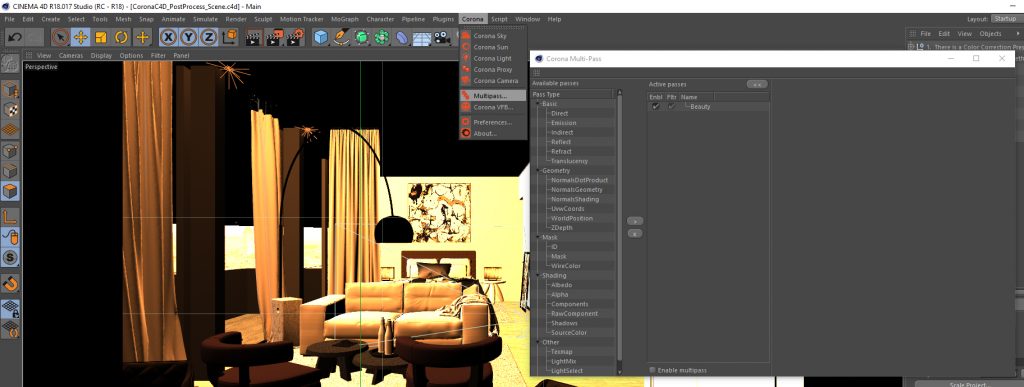
Material preview settings moved to main preferences
This makes it easier to access – do note that you can still override this global value for each material if required.
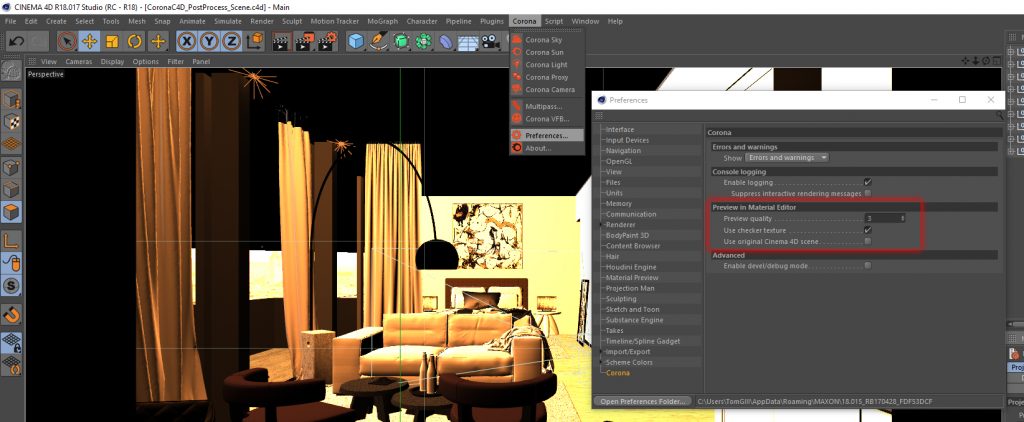
Comprehensive override summary in the VFB
- Detailed hint is now shown in both the native Picture Viewer and the Corona VFB
- Fast selection of camera overrides of specific values in the render settings
Other changes
- Updated render settings
- Updated Layered material (renamed from Blend) – now simplified, and with added layers
- Emission slot in Corona Standard material replaced with self-illumination: for key light sources in the scene, use the Corona LightMtl instead.
- LOTS of other minor modifications to improve ease of use and workflow!
Bug Fixes
- Fixed crashes when doing certain modifications in Multipass
- Fixed various crashes in VFB
- Fixed bug preventing use of the Corona VFB after changing the C4D layout
- Fixed Normal map
- Default to linear color space in textures under normal map
- Fixed crashes in complex subshaders in Corona shaders
- Fixed crashes in Corona Bitmap
- Fixed crop and placement in Corona Bitmap
- Fixed UDIM in Corona Bitmap
- Fixed undos in Multipass
- Fixed undos in various Corona commands (Corona Sky, Corona Camera)
- Fixed problems with batch render
- Fixed C4D IRR when rendering without limits
- Fixed support of Sun Expression tag
- Fixed problem with normals in exported Corona Proxy
- Fixed handling of animated Corona Proxy
- Fixed various instabilities in material previews
- Fixed problems with exporting some complex objects with non-trivial matrix
- Fixed problems with color space of images rendered in the Picture Viewer
- Fixed various installation problems
What’s Next
With Alpha 6 released, it’s time to focus on Alpha 7! The main focus for A7 will be the rewriting of Interactive Rendering, Team Rendering and Motion Blur code so that we can easily fix all of their problems and instabilities, and fix all bugs reported so far.
Until now we’ve been sending out emails when daily builds are released, but from A7 onward we’ll be using the same process as the 3ds Max version, with the announcements of new daily builds happening on our forums. If you want to keep up with each daily build, please be sure to check the forums regularly!
Download Link and Resources
Download Corona for C4D Alpha 6 final for either Mac or Windows at:
https://corona-renderer.com/download/
Forums:
https://corona-renderer.com/forum/index.php#c4
Thank you!
That’s it for this release! We’d like to thank all of you for testing Corona for C4D and letting us know about any problems you encountered and features that you wanted to request – you are all a vital part of making Corona for C4D the best it can be!
Merry Christmas and a Happy New Year!
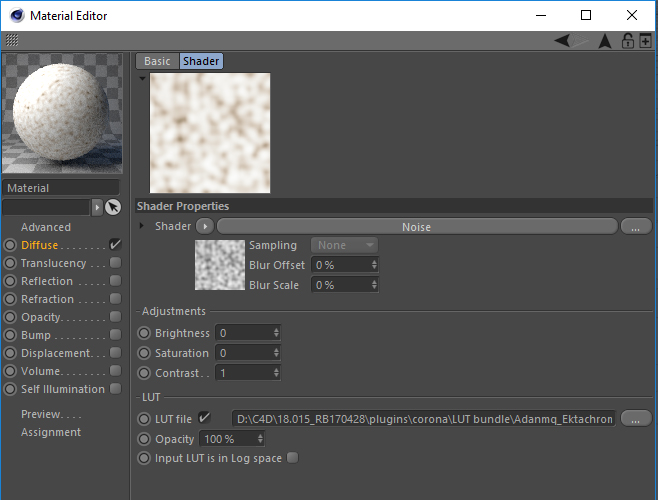
Great ! Will we see the IPR one day ?
Thanks
You can use C4D’s Interactive render mate, corona got the best integration for native C4D users.
Hi, there isn’t really reliable IR in Corona for C4D yet. It will be however implemented really soon.
Congrats guys and happy Christmas!
Congrats !
Will the take system work with the next release?
Happy New Year!
Can you please add a node-based material editor? i literally can’t live without that.
Hi, yes, that’s planned! You can track the development and planned features at https://trello.com/b/dgI8vjDb/corona-road-map-cinema-4d
will it be a node base material editor for conona for C4d ?
Hi, this is actually planned for the beta2 version: https://trello.com/b/dgI8vjDb/corona-road-map-cinema-4d
hey there, cannot find the mac version anymore? is it still available?
It’s not the version for Mac that isn’t available, it’s the Alpha version that isn’t available, because the final release is out 🙂 See https://blog.corona-renderer.com/corona-renderer-3-for-cinema-4d-released/ for details – Mac and Windows version available of that, with 45 day free trial. Thanks!
But didn’t you say that it would be free for everyone to use even after the release? Here are the exact words from your site:
WHAT ABOUT DOWNLOADING THE OLDER FREE VERSION – ALPHA 6?
We have an earlier version available for free, forever, that you can even use commercially. It’s also a great way to take your time and learn about rendering. Get it here!
The link doesn’t allow you to download it, so whats the case in promising something that is not available?
Regards,
That statement refers to Alpha 6 for 3ds Max, a much less developed product than Alpha 6 for Cinema 4D was (since the Cinema 4D version was built on a much later build of Corona). We are still looking into what might be possible with Corona Renderer for Cinema 4D, as it is a much trickier situation – we’d have to “uncode” features to take it back to Alpha 6 for 3ds Max, and there may be a better solution than doing that. No other news at the moment though, sorry.
buongiorno,
purtroppo non posso acquistare il programma per ora a causa perdita lavoro, ma volevo approfittare da come scrivete nel vostro sito, della versione precedente gratuita ALPHA6 tanto per iniziare a capire le funzionalità e perfezionare alcuni render fatti con cinema e pubblicizzarmi un po’.
Il link da voi inserito per scaricarlo però ti riporta sempre alla pagina di download della versione a pagamento di renderer 5, quindi chiedo gentilmente se fosse possibile avere un link corretto e provare questo motore che mi sembra ottimo. Grazie Simone Vivaldo
Hi! English only please – I have used Google Translate, so I think I know what the question is 🙂
Unfortunately, there is no Alpha 6 for Cinema 4D, as Corona was already at version 3 when the Cinema 4D version came out, so it already had a feature set well beyond what is in the Alpha 6 (which means it can’t be given away for free).
Best regards,
Tom